Abstract
Strains 6, 15, 98, 110, and 145 of Cryptococcus neoformans serotype A vary in capsule size, animal virulence, and susceptibility to in vitro phagocytosis. The isolated capsular polysaccharides (CPSs) differ in monosaccharide composition ratios and molecular size, as determined by gel filtration. The purpose of this investigation was to characterize the binding of CPSs to capsule-free mutants of C. neoformans and to examine CPSs from these strains for differences in their ability to bind, to determine whether such differences might explain the variation in the pathobiology of these strains. CPSs were partially periodate oxidized, tyraminated, iodinated with 125I, and used in binding studies with two capsule-free mutants of C. neoformans, strain 602 and Cap59. Binding was specific for yeast species and for polysaccharide and was saturable, which is consistent with a receptor-mediated mechanism of attachment. Binding occurred rapidly and was only slowly reversible. Binding was also independent of pH from pH 5.5 to 8, of cation concentrations, and of competition by sugars up to 1.0 M concentrations. Only a portion of CPS was capable of binding, and strains varied in the extent to which their CPS bound. CPS-15-IV (peak IV was the major polysaccharide peak on DEAE-cellulose chromatography of CPS from strain 15) had the highest proportion of binding (40%), followed by CPS from strains 98, 6, 145, 110, and 15-III (peak III was an earlier eluting fraction of CPS from strain 15). The CPSs differed similarly in their ability to competitively inhibit binding. Treatment of CPS, but not yeast cells, with proteinase XIV abolished binding without altering the CPS gross structure. Treatment of yeast cells with proteases, heat, or formaldehyde did not alter binding, and both strain 602 and Cap59 bound CPS similarly. Binding to encapsulated yeast cells was minimal.
Full text
PDF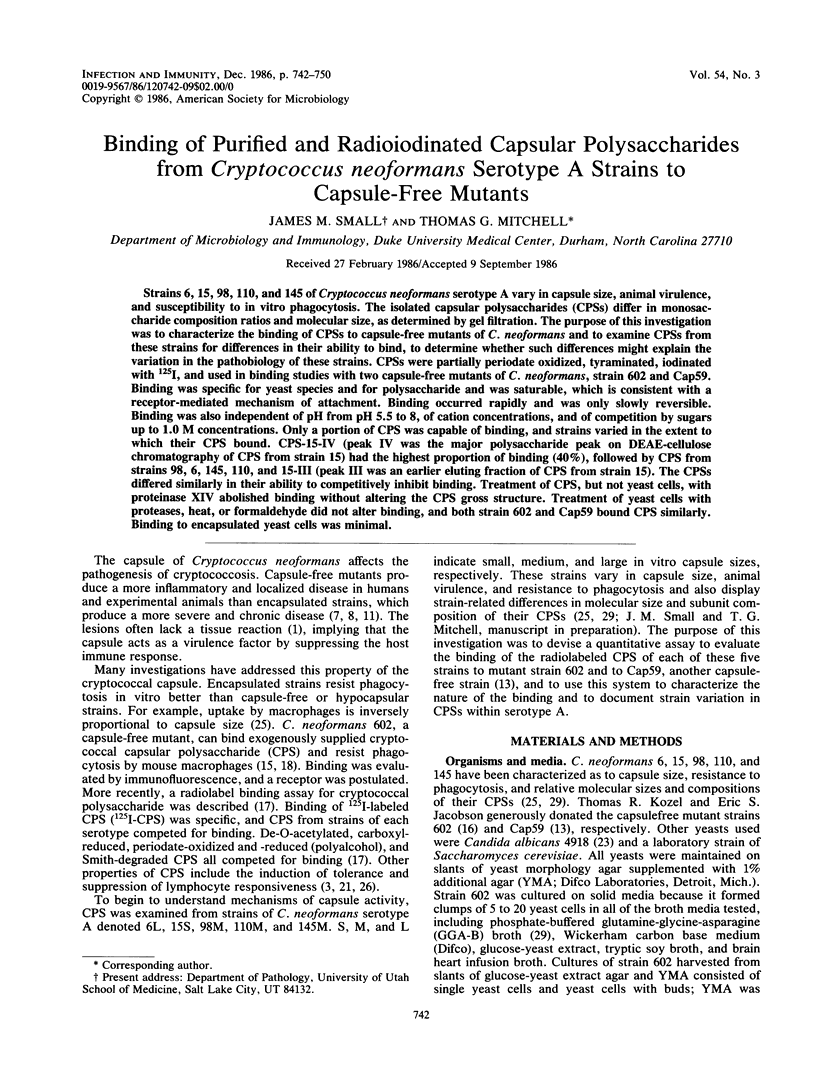

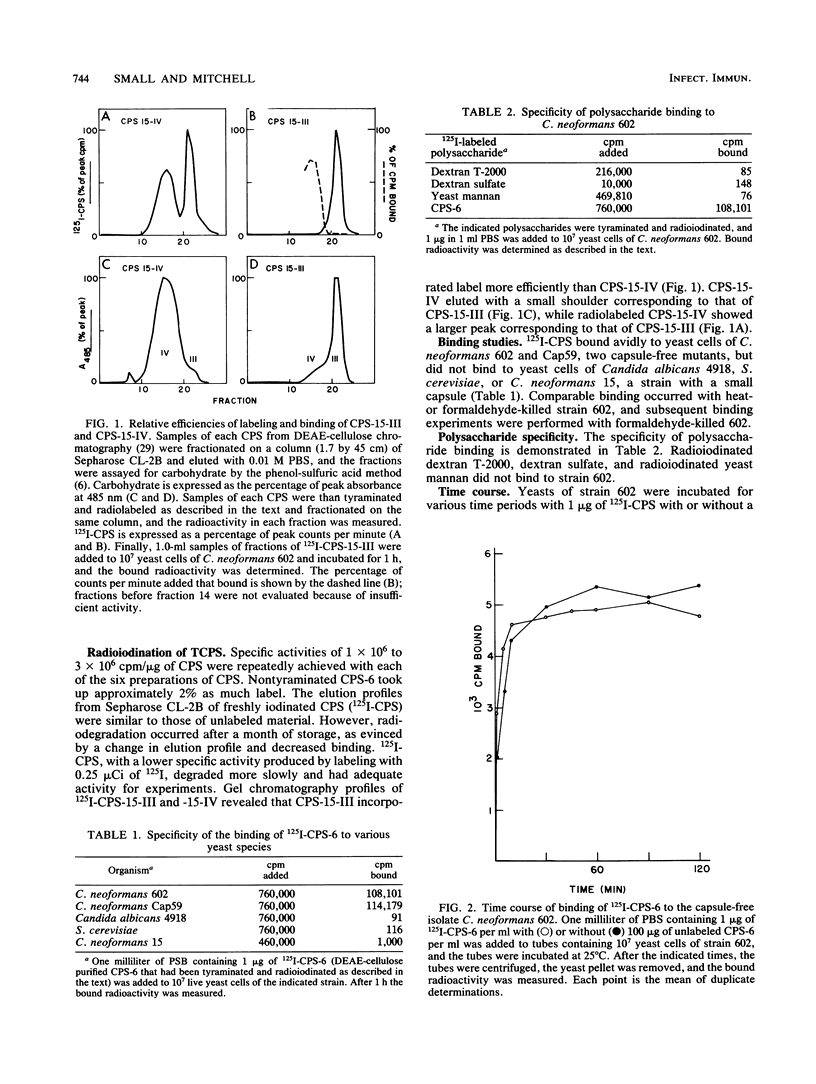
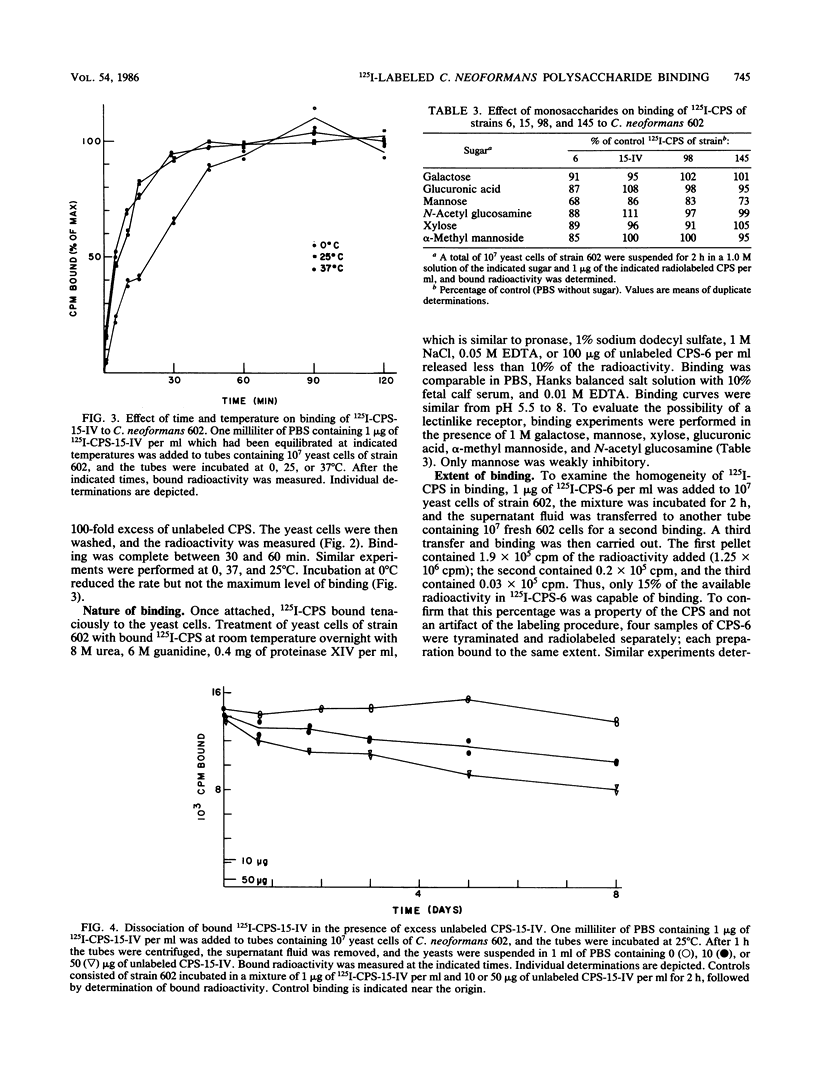

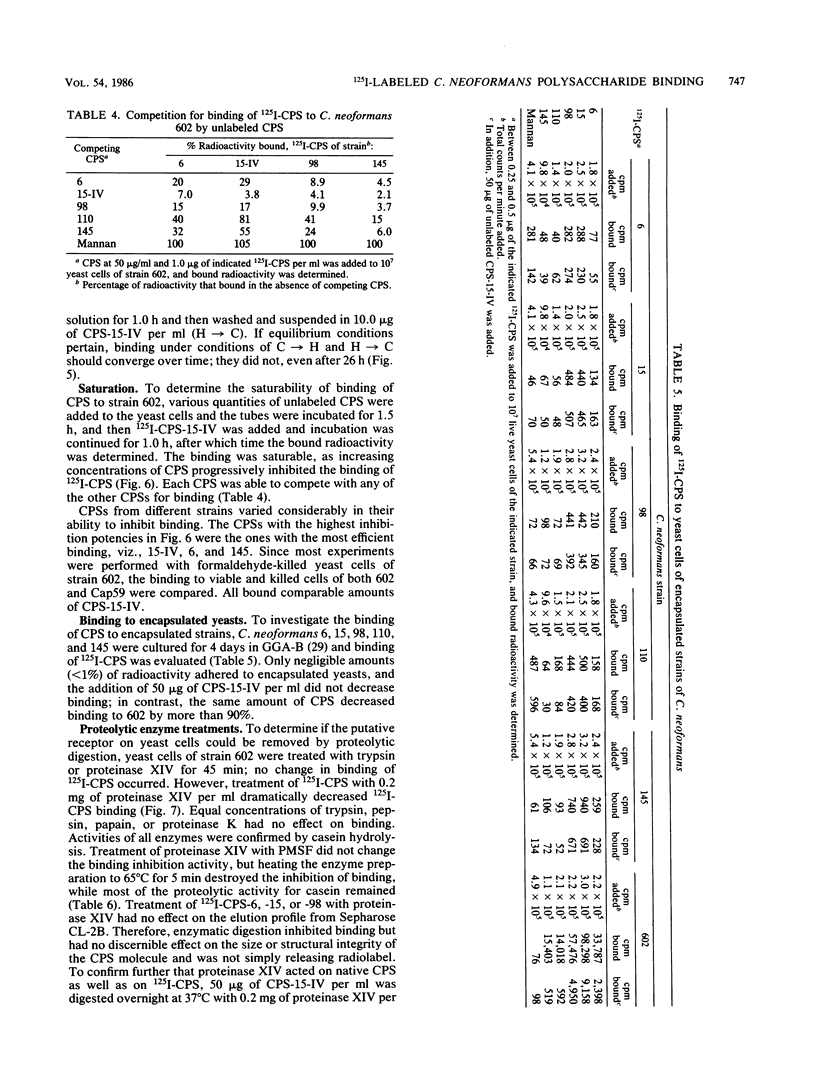
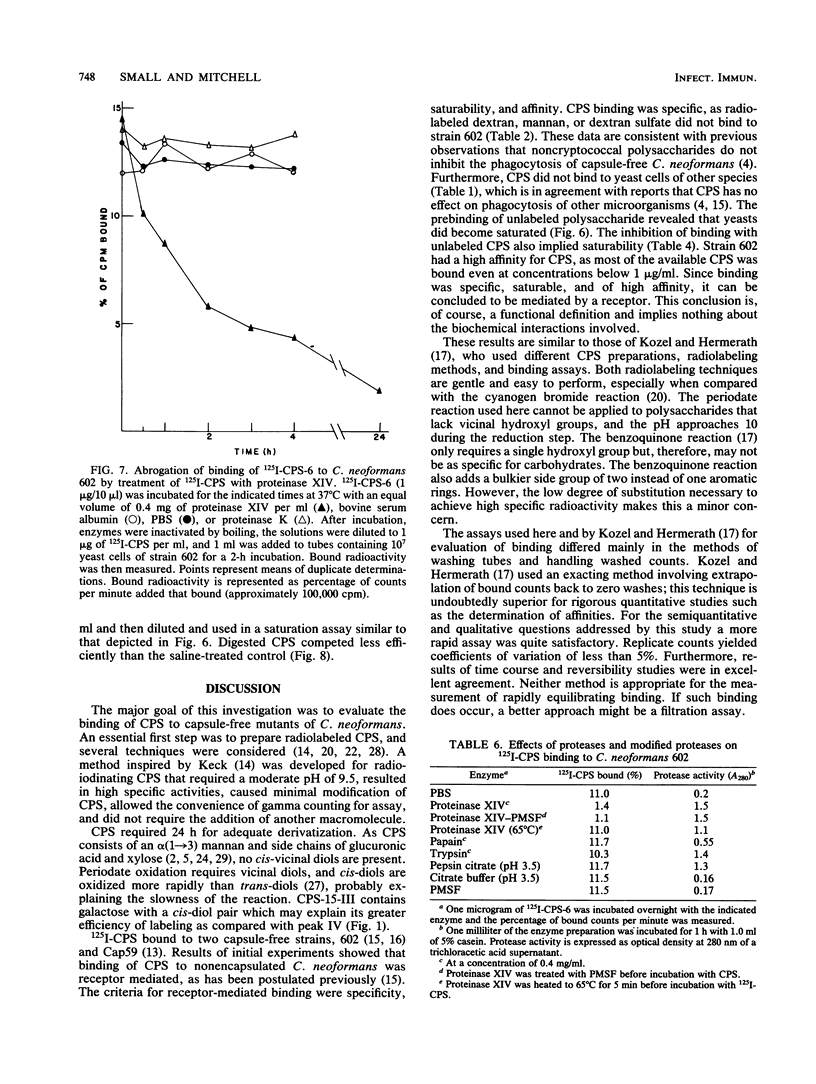
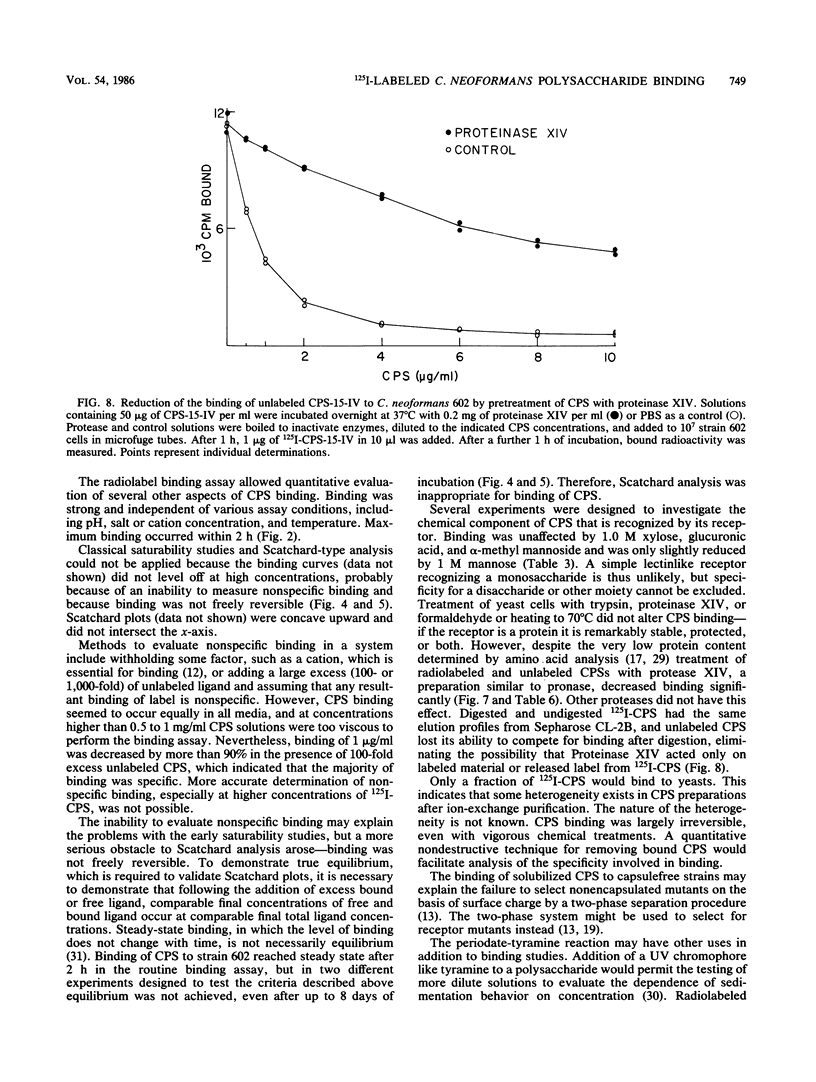
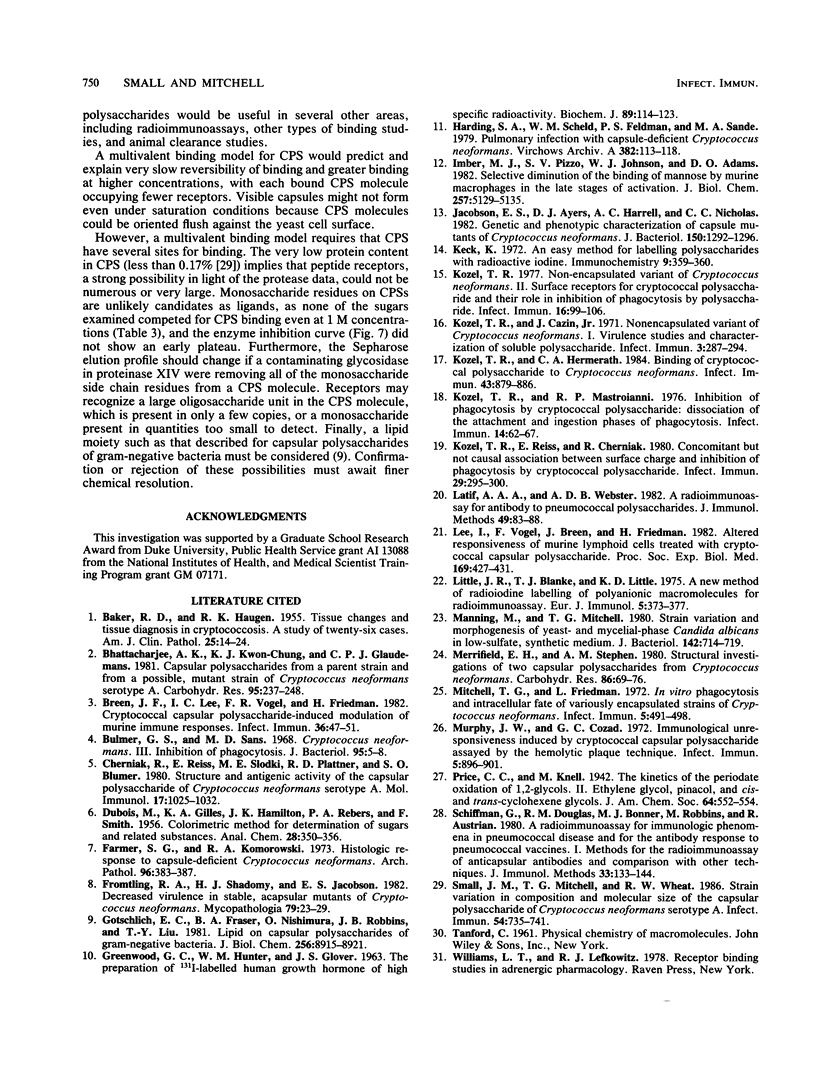
Selected References
These references are in PubMed. This may not be the complete list of references from this article.
- BAKER R. D., HAUGEN R. K. Tissue changes and tissue diagnosis in cryptococcosis; a study of 26 cases. Am J Clin Pathol. 1955 Jan;25(1):14–24. doi: 10.1093/ajcp/25.1.14. [DOI] [PubMed] [Google Scholar]
- Bhattacharjee A. K., Kwon-Chung K. J., Glaudemans C. P. Capsular polysaccharides from a parent strain and from a possible, mutant strain of Cryptococcus neoformans serotype A. Carbohydr Res. 1981 Sep 16;95(2):237–248. doi: 10.1016/s0008-6215(00)85580-9. [DOI] [PubMed] [Google Scholar]
- Breen J. F., Lee I. C., Vogel F. R., Friedman H. Cryptococcal capsular polysaccharide-induced modulation of murine immune responses. Infect Immun. 1982 Apr;36(1):47–51. doi: 10.1128/iai.36.1.47-51.1982. [DOI] [PMC free article] [PubMed] [Google Scholar]
- Bulmer G. S., Sans M. D. Cryptococcus neoformans. 3. Inhibition of phagocytosis. J Bacteriol. 1968 Jan;95(1):5–8. doi: 10.1128/jb.95.1.5-8.1968. [DOI] [PMC free article] [PubMed] [Google Scholar]
- Cherniak R., Reiss E., Slodki M. E., Plattner R. D., Blumer S. O. Structure and antigenic activity of the capsular polysaccharide of Cryptococcus neoformans serotype A. Mol Immunol. 1980 Aug;17(8):1025–1032. doi: 10.1016/0161-5890(80)90096-6. [DOI] [PubMed] [Google Scholar]
- Farmer S. G., Komorowski R. A. Histologic response to capsule-deficient Cryptococcus neoformans. Arch Pathol. 1973 Dec;96(6):383–387. [PubMed] [Google Scholar]
- Fromtling R. A., Shadomy H. J., Jacobson E. S. Decreased virulence in stable, acapsular mutants of cryptococcus neoformans. Mycopathologia. 1982 Jul 23;79(1):23–29. doi: 10.1007/BF00636177. [DOI] [PubMed] [Google Scholar]
- GREENWOOD F. C., HUNTER W. M., GLOVER J. S. THE PREPARATION OF I-131-LABELLED HUMAN GROWTH HORMONE OF HIGH SPECIFIC RADIOACTIVITY. Biochem J. 1963 Oct;89:114–123. doi: 10.1042/bj0890114. [DOI] [PMC free article] [PubMed] [Google Scholar]
- Gotschlich E. C., Fraser B. A., Nishimura O., Robbins J. B., Liu T. Y. Lipid on capsular polysaccharides of gram-negative bacteria. J Biol Chem. 1981 Sep 10;256(17):8915–8921. [PubMed] [Google Scholar]
- Harding S. A., Scheld W. M., Feldman P. S., Sande M. A. Pulmonary infection with capsule-deficient cryptococcus neoformans. Virchows Arch A Pathol Anat Histol. 1979 May 14;382(1):113–118. doi: 10.1007/BF01102745. [DOI] [PubMed] [Google Scholar]
- Imber M. J., Pizzo S. V., Johnson W. J., Adams D. O. Selective diminution of the binding of mannose by murine macrophages in the late stages of activation. J Biol Chem. 1982 May 10;257(9):5129–5135. [PubMed] [Google Scholar]
- Jacobson E. S., Ayers D. J., Harrell A. C., Nicholas C. C. Genetic and phenotypic characterization of capsule mutants of Cryptococcus neoformans. J Bacteriol. 1982 Jun;150(3):1292–1296. doi: 10.1128/jb.150.3.1292-1296.1982. [DOI] [PMC free article] [PubMed] [Google Scholar]
- Keck K. An easy method for labelling polysaccharides with radioactive iodine. Immunochemistry. 1972 Mar;9(3):359–360. doi: 10.1016/0019-2791(72)90098-5. [DOI] [PubMed] [Google Scholar]
- Kozel T. R., Cazin J. Nonencapsulated Variant of Cryptococcus neoformans I. Virulence Studies and Characterization of Soluble Polysaccharide. Infect Immun. 1971 Feb;3(2):287–294. doi: 10.1128/iai.3.2.287-294.1971. [DOI] [PMC free article] [PubMed] [Google Scholar]
- Kozel T. R., Hermerath C. A. Binding of cryptococcal polysaccharide to Cryptococcus neoformans. Infect Immun. 1984 Mar;43(3):879–886. doi: 10.1128/iai.43.3.879-886.1984. [DOI] [PMC free article] [PubMed] [Google Scholar]
- Kozel T. R., Mastroianni R. P. Inhibition of phagocytosis by cryptococcal polysaccharide: dissociation of the attachment and ingestion phases of phagocytosis. Infect Immun. 1976 Jul;14(1):62–67. doi: 10.1128/iai.14.1.62-67.1976. [DOI] [PMC free article] [PubMed] [Google Scholar]
- Kozel T. R. Non-encapsulated variant of Cryptococcus neoformans. II. Surface receptors for cryptococcal polysaccharide and their role in inhibition of phagocytosis by polysaccharide. Infect Immun. 1977 Apr;16(1):99–106. doi: 10.1128/iai.16.1.99-106.1977. [DOI] [PMC free article] [PubMed] [Google Scholar]
- Kozel T. R., Reiss E., Cherniak R. Concomitant but not causal association between surface charge and inhibition of phagocytosis by cryptococcal polysaccharide. Infect Immun. 1980 Aug;29(2):295–300. doi: 10.1128/iai.29.2.295-300.1980. [DOI] [PMC free article] [PubMed] [Google Scholar]
- Latif A. A., Webster A. D. A radioimmunoassay for antibody to pneumococcal polysaccharides. J Immunol Methods. 1982;49(1):83–88. doi: 10.1016/0022-1759(82)90368-4. [DOI] [PubMed] [Google Scholar]
- Lee I., Vogel F., Breen J., Friedman H. Altered responsiveness of murine lymphoid cells treated with cryptococcal capsular polysaccharide. Proc Soc Exp Biol Med. 1982 Apr;169(4):427–431. doi: 10.3181/00379727-169-41370. [DOI] [PubMed] [Google Scholar]
- Little J. R., Blanke T. J., Little K. D. A new method of radioiodine labeling of polyanionic macromolecules for radioimmunoassay. Eur J Immunol. 1976 Jun;5(6):373–377. doi: 10.1002/eji.1830050604. [DOI] [PubMed] [Google Scholar]
- Manning M., Mitchell T. G. Strain variation and morphogenesis of yeast- and mycelial-phase Candida albicans in low-sulfate, synthetic medium. J Bacteriol. 1980 May;142(2):714–719. doi: 10.1128/jb.142.2.714-719.1980. [DOI] [PMC free article] [PubMed] [Google Scholar]
- Mitchell T. G., Friedman L. In vitro phagocytosis and intracellular fate of variously encapsulated strains of Cryptococcus neoformans. Infect Immun. 1972 Apr;5(4):491–498. doi: 10.1128/iai.5.4.491-498.1972. [DOI] [PMC free article] [PubMed] [Google Scholar]
- Murphy J. W., Cozad G. C. Immunological unresponsiveness induced by cryptococcal capsular polysaccharide assayed by the hemolytic plaque technique. Infect Immun. 1972 Jun;5(6):896–901. doi: 10.1128/iai.5.6.896-901.1972. [DOI] [PMC free article] [PubMed] [Google Scholar]
- Schiffman G., Douglas R. M., Bonner M. J., Robbins M., Austrian R. A radioimmunoassay for immunologic phenomena in pneumococcal disease and for the antibody response to pneumococcal vaccines. I. Method for the radioimmunoassay of anticapsular antibodies and comparison with other techniques. J Immunol Methods. 1980;33(2):133–144. doi: 10.1016/s0022-1759(80)80004-4. [DOI] [PubMed] [Google Scholar]
- Small J. M., Mitchell T. G., Wheat R. W. Strain variation in composition and molecular size of the capsular polysaccharide of Cryptococcus neoformans serotype A. Infect Immun. 1986 Dec;54(3):735–741. doi: 10.1128/iai.54.3.735-741.1986. [DOI] [PMC free article] [PubMed] [Google Scholar]


